Often you hear people say "Let Nature takes It's course" is regards to animal husbandry. Ever though we do things in a very Natural manner here, when it comes to kidding, this is not place it stand back and not become involved. I would not expect a human mother-to-be to give birth alone, without, at least, the aid of a midwife. The same goes for our goats. We are present at every birth and we always assist to some extent (even if that is just helping to clean off and dry the kids and help them nurse for the first time). Because of this, we have never lost a doe or kid due to complications in child birth.
If your doe knows you, and likes you, she is going to have no problem with you getting involved You helping will not interfere with the bonding of the mother and kid(s), and will more likely help the bonding. Also, if the mother refuses the kid, you will be there to take on as mother as needed.
Here are the steps we use in aiding a normal delivery, these steps assume the kid(s) are in the proper and most common diving position. Steps will vary for situations when the kids are not correctly positioned
1) Put the doe in her clean stall, bedded with straw (not hay) and get your supplies.
2) Sit with the doe and watch her to judge how things are going and progressing.
3) Get a feed bag ready for your garbage bag.
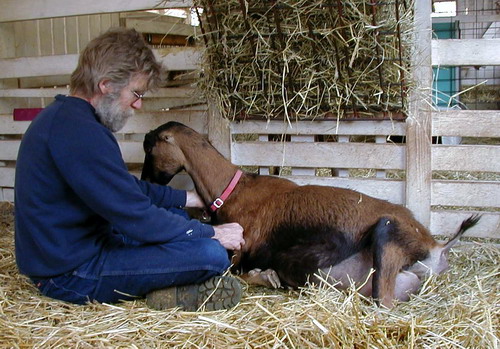
Comfort and emotionally support the doe in her labor.
4) When she seriously starts pushing, get right behind her so you can see how things are going. This is no time to be "shy".
5) Place a feed bag behind the doe to help catch the glop.... there is going to be a lot of mess! Have a couple rolls of paper towels within reach, you will need them throughout the entire birth.
6) You may see the "Bubble" or it might break before it comes out. Either are normal. You can break the bubble without fear of harming the kids. We usually prick it with a thick bit of straw because that is what is most handy. Breaking the bubble relieves some of the pressure and the doe my rest a little after you break it.
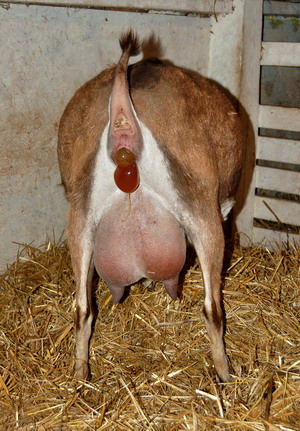
The Bubble
Here you actually see a "duel" bubble.
One is her "water", a more flaccid "bubble", and the other is a more taught bubble that the kid is in.
If you have not yet, LOOK AT THESE DETAILED KIDDING PHOTOS
7) Look for a foot; it will be white. If the sole of the foot is pointing down, the kid is coming out head first: "diving". If the sole of the hoof is pointing up, the kid is coming our rear first: "breach". Both positions are normal. When you see a diving kid foot, you may grab it carefully and give it a bit of a pull when the doe pushes. I do this, just in case the elbows are back, this will help bring the legs totally forwards (see here). When you pull, always pull when the doe pushes and pull out and slightly down (if the doe were standing). If she is laying down, you pull in the direction of out and slightly down if she were standing. Look for the other foot. The foot can show and then get pulled back in. This can happen a few times.
8) When you see the other foot and can grab that and give it a pull to make sure it is fully forward. Pull one foot and then the other, not both at the same time. Start looking for the nose and tongue in the diving kid. The tongue is always sticking out for some reason.
9) When you have both feet and see the nose, you can pull harder. The most difficult part is now coming up: getting the head out. The doe's rear end will stretch out and she may yell. It might seem like the head will never get through that little hole, but it will. If the kid is really big, you might have to pull really hard. Pull when she pushes. Talk to the doe and encourage her. It helps to have one person to comfort the doe and one person to pull. If the doe is laying down, position your foot so you can brace her rear feet and she can push against you.
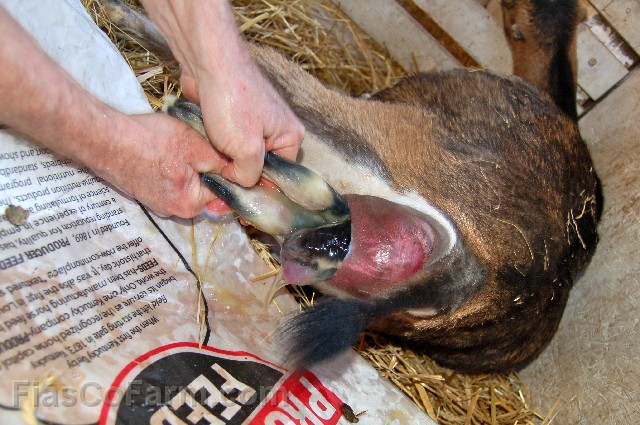
10) Have a puppy training pad (aka. "puppy pad" or "wee-wee pad", we buy than in boxed of 100 at a time) ready to place in front of the doe.
11) Have the helper ready with paper towels.
12a) Once the head is out, the doe may, or may not, rest a little. If the doe does take a short break with just the head sticking out, you can take this time to wipe the mouth and nose with paper towels. Even stick your finger in the mouth a little to help clear it. I have never used any sort of special tool or bulb for this, just paper towels and my fingers.
12b) If the doe gets the kid half way out, where you see the chest, go ahead and help her by pulling the kid the rest of the way out.
12c) Once the head is out, the kid may come out very quickly. The umbilical cord will always stretch and break on it's own, you will never need to cut it.

13) Once the kid is out, grab the rear legs at the ankles and hold the kid upside down so he dangles and have the helper wipe the nose and mouth with paper towels. You hold them this way so any fluid will quickly drain out of the mouth and lungs. Hold on tight, the kid will be slippery.
14) Place the kid right in front of the doe, on the puppy pad that was put in front of the doe so she can start cleaning her baby.

15) Pull off as much of the bigger globs of goo as you can as fast as you can. You want the doe to concentrate on cleaning her baby, not eating goo globs. If she doesn't start cleaning the kid right away, push her head toward the kid so she notices it. You can put a little goo on her nose. She will lick this off, and the taste will help her instincts kick in.
16) Pick up the baby, remove the pad and give them a new pad. Keep cleaning off the goo.

17) Have the helper roll up the soiled feed bag and paper towels that are now strewn all over and put them in your garbage bag. Gather the soiled hay and glob from behind the doe and put it in the bag.
18) Be ready for another kid as you work on the first one.
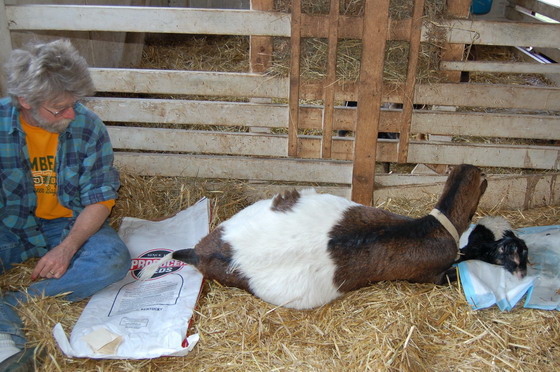
19) Put the kid on a new puppy pad.
20) Repeat delivery assistance if necessary.
21) Put the kid(s) on a new/dry puppy pad.
22) Put another clean puppy pad elsewhere in the stall and move the kid(s) to it so you can get the doe to stand up and/or move.
23) Clean up the birth area.
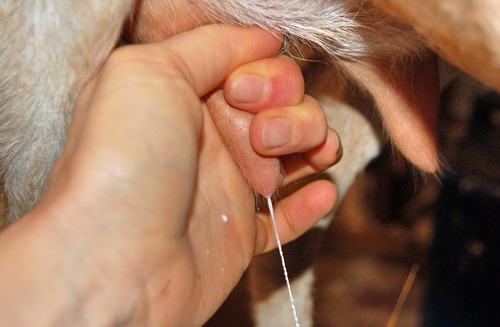
24) Squeeze both teats to make sure they are working and not plugged. If they are plugged, squeeze as much as is needed to clear them.
25) Give the mom a well deserved grain snack.
26) While the mom is eating, take a baby, even if he has not stood yet and hold them to the teat to try to nurse. It is easier to do this when you have given the doe a haircut. Your will be able to see better, the kid will be able to see better and won't waste his time sucking on hair. Trying to ge the kid to nurse for the first time can be incredibly frustrating. Be patient and keep trying; the kid needs to nurse. Don't try pushing the kids head toward the teat, they will resist pushing. Instead hold them and aim them at the teat. You can also use your fingers to aim the teat at the kid. We pretty much always have had our kids have at least one really good suck before they can even stand.
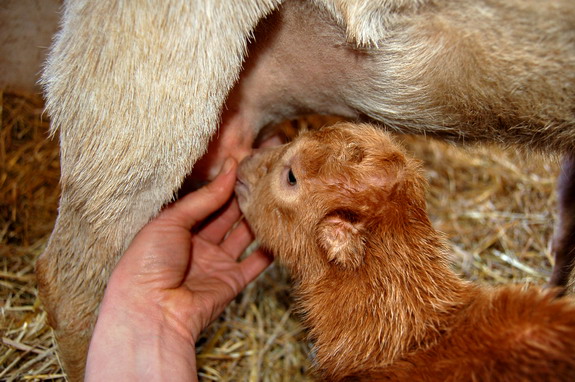
27) Wipe off the doe's rear end, udder and legs. Since you gave the doe a haircut, this will be easier to do and it will be easier to keep her clean and dry..
28) If it is cold, finish drying the kids with a hair drier.
29) Once the kids are dry, dip their umbilical cords in 7% iodine (I'll add directions for this soon).
30) If it is really cold, you can now put the dry kids in sweaters or fleece coats. Even is it well under freezing, we never bring the kids in the house. They need to be with their mother. If the kids can stand and nurse and you have a proper housing situation, the kid will not freeze to death.
31) Once you have seen the kids stand and nurse on their own, your job is done and you can leave the new family alone to bond. Do not leave the kids until they have stood on their own and nursed.
32) Check back an hour or so later to make sure the kids are nursing and to remove the afterbirth from the stall (if the doe hasn't eaten it already).
33) Enjoy your new goatbabies.
34) The next day make sure to rub the doe's vagina area with Molly's Marvelous Salve, it will help the swelling and speed healing of this not quite sore area.
Read my narratives and descriptions of Fias Co Farm kiddings here.